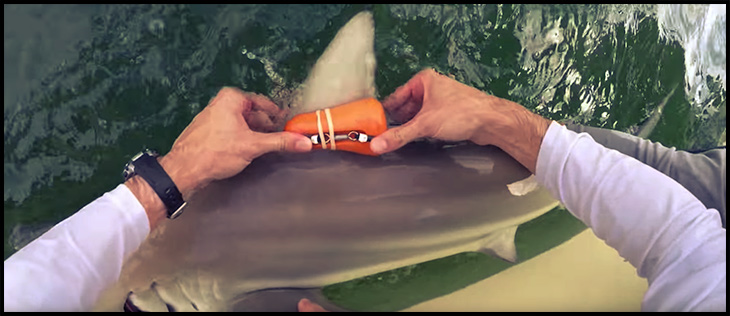Shark Tracking Science: What we Know about Stress
Blue Skies and Blacktips
It’s a blueberry-sky day in Florida, and a small group is fishing for sharks off the coast. The group is conservation-minded, as are most sport fishermen, so the plan is to release any sharks they catch, often done with full confidence that the animal will be undamaged by the encounter. Or will it? “The assumption that a shark swims away and lives a long, happy life after that isn’t necessarily true.” The person calling the assumption into question is Dr. Nick Whitney of the Anderson Cabot Center for Marine Life. “We’re trying to figure out what happens to sharks after they’re caught and released alive.”
It isn’t long before one of the rods bends and someone hauls in the first catch of the day: a blacktip shark. The blacktip is a popular sport fish in Florida. It is five feet of muscle and often provides fishermen with a show as it leaps out of the water when chasing prey. “Most of the guys who are doing catch-and-release fishing are doing it for the benefit of the animal,” says Whitney. “They want the animal to survive, grow up, be caught again.” Both scientists like Whitney and shark fishermen of today want sharks in the water. However, that hasn’t always been the case.
Does Jaws have stress?
University of Miami biologist Austin Gallagher said in a podcast that sharks are as capable of experiencing stress as any other living creature. “Every organism on this planet experiences stress in some way, from a single-celled organism to a student studying for a test.” Stress is viewed as physiological changes in body chemistry, said Gallagher, and can be induced in sharks by changes in salinity, warming waters, and especially when animals are caught and released.
“You look at a shark and it’s pretty mean looking, with the teeth hanging out, and you would not think that it has any stress. But that’s not the case: shark populations are decreasing worldwide due to fishing.” Gallagher says that concern for sharks has improved a great deal in the past thirty years or so. “In the days when Jaws came out, the feeling was the only good shark is a dead shark,” and fishermen would take sharks purely for the optics of standing beside its bleeding corpse on the dock to pose for a picture. “Fortunately, the days of dragon-slaying are coming to an end.”
A Shark Door Prize
As the blacktip is brought alongside the boat, the crew scrambles to quickly immobilize it. Whitney rolls the shark on its back, inducing a strange state called tonic immobility. The shark, thrashing and pulling just seconds earlier, seemingly falls asleep. Though the group will, like most sport fishermen, release the shark after it’s brought in, the animal will leave with a small souvenir: an acceleration data logger.

The logger is a small device called an accelerometer that will be attached to the dorsal fin of the shark to record the shark’s tail beat, its depth, and pitch (the angle at which it swims). This is the first time acceleration data loggers have been used to study shark post-release mortality.
NOAA says that telemetry devices are used in various forms on everything from salmon smolts to whales and provide vital insights into marine animal behavior. “These observations significantly improve our understanding of ecosystem function and dynamics. Sensors carried by animals deliver high-resolution physical oceanographic data at relatively low cost, and often in difficult areas to study, such as the Arctic.”
In this case, the accelerometer has a strap that is designed to begin deteriorating as soon as it hits the salt water. After being on the shark for about 24 hours, the strap will fall off. The monitor, attached to a small float, will surface and begin to transmit a radio signal that can be detected from about ten miles away.
Recovery and Recording
Karissa Lear of Mote Marine Laboratory is setting up the equipment to retrieve the devices two days after the catching and tagging. Despite the exciting aspects of working with sharks, she says that looks can sometimes be deceiving. “I tell people what I do, and they’re like, ‘Oh you have the greatest job ever!’ They don’t realize that I spend about 90% of my time sitting at my desk writing grants and recording data.”

The crew follows a pinging radio signal toward each of the devices using an antenna that Lear holds near the bow of the boat. Before long, the boat approaches an orange float about eight inches long. Attached to the float is the monitoring device, which the crew picks up using a net. In the end, they’re able to retrieve 100% of the data loggers.
What It All Means
Initial reports from the data loggers show that 91% of the blacktips were able to survive the process of being caught, tagged, and released. It took the sharks roughly eleven hours to recover from the ordeal. Rob Nelson of Untamed Science says that, while the shark data from this trip may be one small piece of a bigger puzzle, the real reward may lie elsewhere: “The biggest result of this study may be simply that using data loggers like this is extremely effective at looking at fishing techniques to determine whether or not a shark survives a particular fishing method.”
Find out more about the topics mentioned here:
Related Topics
Blue Skies and Blacktips
It’s a blueberry-sky day in Florida, and a small group is fishing for sharks off the coast. The group is conservation-minded, as are most sport fishermen, so the plan is to release any sharks they catch, often done with full confidence that the animal will be undamaged by the encounter. Or will it? “The assumption that a shark swims away and lives a long, happy life after that isn’t necessarily true.” The person calling the assumption into question is Dr. Nick Whitney of the Anderson Cabot Center for Marine Life. “We’re trying to figure out what happens to sharks after they’re caught and released alive.”
It isn’t long before one of the rods bends and someone hauls in the first catch of the day: a blacktip shark. The blacktip is a popular sport fish in Florida. It is five feet of muscle and often provides fishermen with a show as it leaps out of the water when chasing prey. “Most of the guys who are doing catch-and-release fishing are doing it for the benefit of the animal,” says Whitney. “They want the animal to survive, grow up, be caught again.” Both scientists like Whitney and shark fishermen of today want sharks in the water. However, that hasn’t always been the case.
Does Jaws have stress?
University of Miami biologist Austin Gallagher said in a podcast that sharks are as capable of experiencing stress as any other living creature. “Every organism on this planet experiences stress in some way, from a single-celled organism to a student studying for a test.” Stress is viewed as physiological changes in body chemistry, said Gallagher, and can be induced in sharks by changes in salinity, warming waters, and especially when animals are caught and released.
“You look at a shark and it’s pretty mean looking, with the teeth hanging out, and you would not think that it has any stress. But that’s not the case: shark populations are decreasing worldwide due to fishing.” Gallagher says that concern for sharks has improved a great deal in the past thirty years or so. “In the days when Jaws came out, the feeling was the only good shark is a dead shark,” and fishermen would take sharks purely for the optics of standing beside its bleeding corpse on the dock to pose for a picture. “Fortunately, the days of dragon-slaying are coming to an end.”
A Shark Door Prize
As the blacktip is brought alongside the boat, the crew scrambles to quickly immobilize it. Whitney rolls the shark on its back, inducing a strange state called tonic immobility. The shark, thrashing and pulling just seconds earlier, seemingly falls asleep. Though the group will, like most sport fishermen, release the shark after it’s brought in, the animal will leave with a small souvenir: an acceleration data logger.
![]()
The logger is a small device called an accelerometer that will be attached to the dorsal fin of the shark to record the shark’s tail beat, its depth, and pitch (the angle at which it swims). This is the first time acceleration data loggers have been used to study shark post-release mortality.
NOAA says that telemetry devices are used in various forms on everything from salmon smolts to whales and provide vital insights into marine animal behavior. “These observations significantly improve our understanding of ecosystem function and dynamics. Sensors carried by animals deliver high-resolution physical oceanographic data at relatively low cost, and often in difficult areas to study, such as the Arctic.”
In this case, the accelerometer has a strap that is designed to begin deteriorating as soon as it hits the salt water. After being on the shark for about 24 hours, the strap will fall off. The monitor, attached to a small float, will surface and begin to transmit a radio signal that can be detected from about ten miles away.
Recovery and Recording
Karissa Lear of Mote Marine Laboratory is setting up the equipment to retrieve the devices two days after the catching and tagging. Despite the exciting aspects of working with sharks, she says that looks can sometimes be deceiving. “I tell people what I do, and they’re like, ‘Oh you have the greatest job ever!’ They don’t realize that I spend about 90% of my time sitting at my desk writing grants and recording data.”

The crew follows a pinging radio signal toward each of the devices using an antenna that Lear holds near the bow of the boat. Before long, the boat approaches an orange float about eight inches long. Attached to the float is the monitoring device, which the crew picks up using a net. In the end, they’re able to retrieve 100% of the data loggers.
What It All Means
Initial reports from the data loggers show that 91% of the blacktips were able to survive the process of being caught, tagged, and released. It took the sharks roughly eleven hours to recover from the ordeal. Rob Nelson of Untamed Science says that, while the shark data from this trip may be one small piece of a bigger puzzle, the real reward may lie elsewhere: “The biggest result of this study may be simply that using data loggers like this is extremely effective at looking at fishing techniques to determine whether or not a shark survives a particular fishing method.”
































































































